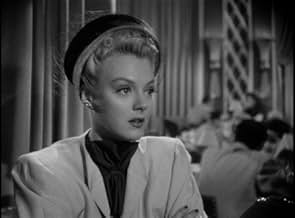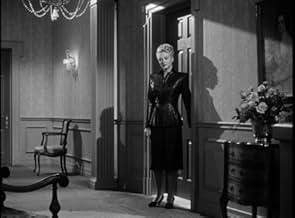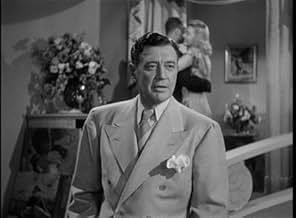Ajouter une intrigue dans votre langueA wealthy wife suspects her artist husband's affair with his model. He poisons his wife for inheritance but faces unexpected consequences after her death. A thriller exploring greed, betraya... Tout lireA wealthy wife suspects her artist husband's affair with his model. He poisons his wife for inheritance but faces unexpected consequences after her death. A thriller exploring greed, betrayal, and the consequences of criminal actions.A wealthy wife suspects her artist husband's affair with his model. He poisons his wife for inheritance but faces unexpected consequences after her death. A thriller exploring greed, betrayal, and the consequences of criminal actions.
- Réalisation
- Scénario
- Casting principal
- George
- (non crédité)
- Messenger Boy
- (non crédité)
- Artist
- (non crédité)
- Henry Loring
- (non crédité)
- Whistler
- (non crédité)
- Jorgensen
- (non crédité)
- McLaren aka Mac
- (non crédité)
- Butler
- (non crédité)
- Girl
- (non crédité)
- Detective Lieutenant
- (non crédité)
- Girl
- (non crédité)
Avis à la une
*** (out of 4) T
he sixth film in Columbia's series and the last to feature Richard Dix. In the film Dix plays an artist who begins dating a younger woman (Leslie Brooks) while waiting for his wife to die. After the wife dies he marries the younger woman but soon she starts to fear that he might have killed the first wife. This is another good entry in the series that manages to build some nice suspense with its very entertaining story and another fine performance by Dix. Not only is Dix very good in his role but the supporting cast is great as well. Brooks turns in a very good performance as the woman who begins to suspect the worst. Michael Duane and Mary Currier co-star as a newspaper man and Dix's first wife. The story goes by at a very fast pace and there's some nice twists and turns along the way. The film focuses on a psychological horror aspect, which is where the suspense comes from.
When his wife dies, he does marry again--but has to play a cat-and-mouse game with his new wife when she begins to suspect him of murder.
Dix plays his role quite effectively and Leslie Brooks is stunning as the blonde beauty. She never had a better chance than she does here, but unfortunately Columbia was never able to find anything but supporting roles for her in B-films of the period.
Suspenseful, it takes awhile before the tense proceedings start to tighten up, but it's worth ending for the good finale. MICHAEL DUANE has a small supporting role as an artist but gets star billing.
Well directed by George Sherman, these series are better than average programmers.
In this outing he plays a man married to a woman purely for her money and who falls in love with a younger woman who is after him purely for his (her) money. How the situation is nefariously resolved is the plot, simply and carefully plotted. The way the actors spoke their words beginning with capital letters in this - and other entries in the series - makes me think this must have been adapted and expanded from one of the scripts of the 231 radio plays already aired by then. Whether playing a goodie, baddie or bothie Dix exuded a simple yet intense sincerity, he's basically a baddie with all the usual human failings in here and yet you can still find yourself rooting for the poor mutt. Leslie Brooks as the not-too-bad gold-digger artists model was never more alluring, I was definitely rooting for her! There's a poignant twist at the end, so attention is recommended.
Sadly neglected, about time they were all available on DVD, a nice entry in a nice series for those of us who like the genre.
Again the Whistler just walks around as Narrator. He doesn't get involved in the plot.
The series stars Richard Dix. Here he plays Ralph Harrison, a not great artist who lives off his sick wife's (Mary Currier) money. In the beginning of the film, we see her ordering her own gravestone!
Edith Harrison has a terminal heart condition. When her husband meets model Kay Morrell (the very pretty Leslie Brooks), he falls in love with her. However, a new doctor has gotten Edith out of her sickbed and ready to live again.
Edith goes to her husband's studio to surprise him. She's the one surprised as she overhears him declaring his love for Kay and saying Edith will be gone soon. In fact, he decides to help her along.
Richard Dix is an actor I have a hard time with. I find his acting not good, along with his hairpiece, and he's quite rigid. Sometimes he's a good guy in the Whistler series; here he's a bad one. There's a twist at the end.
This is the best Whistler I've seen.
This is a tale about a mediocre middle aged artist, (Richard Dix as Ralph Harrison) married to a middle-aged wealthy wife (Mary Currier as Edith Harrison). The first scene sets us up for the macabre nature of the tale to come. A woman is ordering an expensive headstone - even in 1946 it will cost five thousand dollars . The stonemason is telling her it will take three months to build such an expensive monument. She says that is OK. Then she gives the name to be put on the headstone - her own. You see, Edith is quite ill with a bad heart and has only months to live and she knows it.
Someone else here mentioned this as the tale of "the inconvenient wife", but it is not at all clear what Ralph's true feelings are for his wife, at least in the beginning. For sure he likes not having to sell sketches in the park, to be able to have his own studio and dabble even though he has no talent, and to entertain his "friends" who are actually just a bunch of parasitic hangers on. However, he seems genuinely troubled and saddened by the doctor's news that his wife has only weeks or months to live. His great misfortune is to befriend ace grifter Kay Morrell just to have someone to talk to during his time of trouble with his wife tied to a sick bed, and then he falls in love with her.
Ralph decides he really wants Kay, Kay really only likes Ralph's money, and Ralph really likes his money too, and he loses that if he divorces Edith. Normally he could just wait out Edith's illness to its inevitable conclusion, but then a monkey wrench is thrown into his plans - a young hot-shot doctor devises a state of the art treatment plan and Edith now has a second lease on life. I'll let you watch for yourself and see how all of this plays out.
This particular whistler entry is the essence of noir - an average man who is on an average man's path until something unexpected comes along, and suddenly that forbidden fruit just looks to good to pass up. Surely he can get away with a bite out of that fruit just once...or not.
Like I said earlier, Dix did an outstanding job in this one. You never really know what his true feelings are deep in his heart, since he plays his cards close to his vest in his role as Ralph and he is fascinating to watch. Kudos also go out to Claire Du Brey who has her Mrs. Danvers like role down pat as the loyal servant of Edith, and also to Leslie Brooks as Kay Morrell who is beautiful and cold as ice as the femme fatale. A highly recommended little B noir.
Le saviez-vous
- AnecdotesThis is the penultimate film of Richard Dix, being 99th out of the 100 he made.
- GaffesAfter Harrison's servant discovers Mrs Harrison lying on the floor, using the bedroom phone tells Loring she hangs up and then calls the doctor. But, the phone downstairs that she originally answered when Loring called is still off the hook and therefore she would not be able to make the call.
- Citations
Ralph Harrison: What's the matter, Darling?
Edith Marie Harrison: Stop acting, Ralph. There's nothing quite so contemptible as a hypocrite.
- ConnexionsFollowed by The Thirteenth Hour (1947)
- Bandes originalesPut The Blame On Mame
Written by Allan Roberts and Doris Fisher
Played during the party in Ralph's studio
Meilleurs choix
- List: "The Whistler" radio episodes
Détails
- Date de sortie
- Pays d’origine
- Sites officiels
- Langue
- Aussi connu sous le nom de
- Секрет Свистуна
- Société de production
- Voir plus de crédits d'entreprise sur IMDbPro
- Durée1 heure 5 minutes
- Couleur
- Rapport de forme
- 1.37 : 1
Contribuer à cette page

































